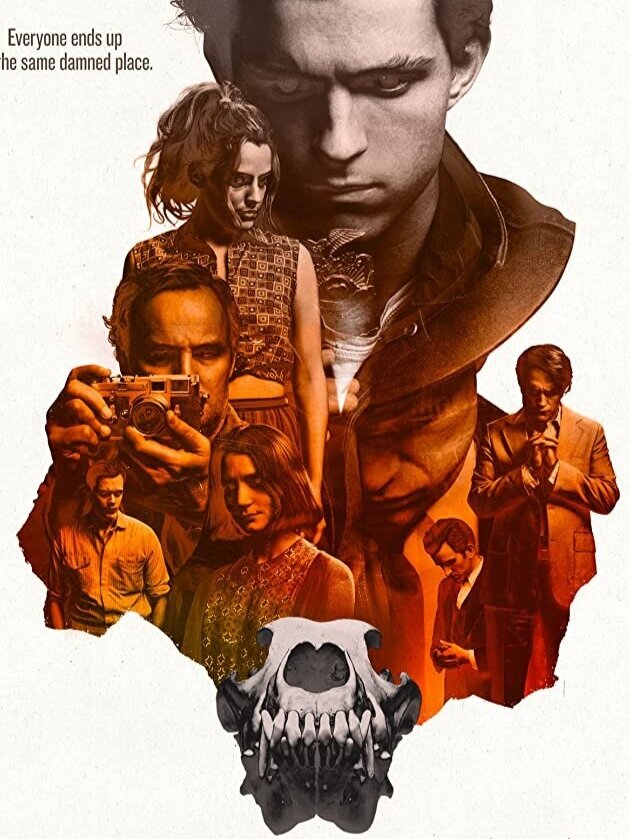‘The Devil All the Time’ Review: A Modern-Day ‘Pulp Fiction’
“The Devil All the Time” is the newest Netflix Original psychological thriller starring Tom Holland and Robert Pattinson based on Donald Ray Pollock’s best-selling 2011 novel of the same name.
“The Devil All The Time” follows a variety of characters in and around the rundown Appalachian towns of Knockemstiff, Ohio and Coal River, West Virginia from 1945 all the way through 1965 whose own personal stories all intertwine into one haunting, twisted tale about the devil inside of everyone.
The film focuses on the life of Willard and Arvin Russell (played by Bill Skarsgard and Tom Holland respectively). Willard is a World War II veteran suffering from severe PTSD from his gruesome experiences in the Pacific Theater who brings his emotional baggage back home with him to Knockemstiff. Arvin, his son, carries the mental trauma from his father’s own PTSD into 1965 as a 19-year-old and experiences the generational effects psychological trauma can be passed on to others.
Along the way, we meet a whole cascade of creative and interesting characters, as the film co-stars the likes of Jason Clarke, Sebastian Stan, Haley Bennett, Riley Keough, and more.
The movie kicks off setting the ominous tone and unsettling atmosphere that will continue consistently throughout the runtime and makes us feel on the edge with shivers down our spine as we brace ourselves for the various psychological thrills we will soon receive.
The film is raw and real and is not afraid of holding back on the violence or the intensely sensitive subject matters it deals with, which is something to respect in cinema. This includes suicide, death in the family, homicide, and affairs. All of these unfold before our eyes onscreen with so many layers that help form the glue between all these different characters and times.
The setting of the film was particularly interesting as it represents a time period in American history that seems neglected for most movies, by taking place in the 1950s and the early 1960s it focuses on that odd period between World War II and Vietnam. It also is set in rural Appalachia between Ohio and West Virginia, a substantial area that seems to be ignored in a lot of stories.
The first great point of focus in reviewing the film is the phenomenal performance from Bill Skarsgard as a veteran suffering from intense duress and emotional trauma after witnessing the brutality of war. Not only is his performance convincing, but it details a harrowing commentary on the nature of veterans struggling with mental health.
However, the absolute standout of the film was Tom Holland himself as Arvin. Holland finally is able to fully extend his acting legs in this film and show how talented of a thespian he really can be. This was the first role he was in where he truly feels like he is playing an adult, rather than a kid or a teenager. Holland is a master of accents and plays an rural Appalachian incredibly well. He also brings a deep darkness in his role that acts as a shadow over his character that, while uncharacteristic of his typical work, he managed to pull off expertly. Arvin is the lens through which the audience views all the events in the film, and we feel his pain when he feels it, and we also get the healthy skepticism and awareness that he has that other characters do not. In a way, Arvin seems the most human and relatable in this film. This makes movie lovers all the more excited for his dramatic performance in the upcoming Russo Brothers film “Cherry.”
The film is labelled a modern-day “Pulp Fiction” because the narrative is a non-linear story intertwining seemingly-unrelated characters in creative and interesting ways. People leading totally separate lives with totally separate experiences cross paths with a script that balances all the characters and timelines well. The movie keeps careful track of it all, and allows what could have easily been a confusing, jumbled narrative to become a storyline anyone can follow and enjoy.
Lastly, the story packs a very powerful message about the role of religion in peoples’ lives. While most people will say that religion provides a powerful spiritual relief, this movie shows how religion can be a negative in one’s life. The film explores toxic Christianity through the film’s primary antagonist Reverend Preston Teagardin, played by Robert Pattinson. Not only is his performance frightening, but he serves as the dark and twisted antithesis for what religion is supposed to be. He is corrupt, unhinged, radical and delusional all because of his twisted faith which he uses to excuse his horrendous actions throughout the film. This is also explored earlier in the film through his predecessor Roy Laferty, played by Harry Melling, who goes so far as to commit murder to try and prove his faith. This sort of religious fanaticism and radicalism helps showcase the negatives religion can have on individuals.
The film is not without its own faults, no matter how minor. One criticism that will slowly become apparent while watching is that Tom Holland, who was advertised as the main character of the film in the marketing, does not make his appearance until over 45 minutes in, which is nearly one-third of the runtime. Similarly, Robert Pattinson, another focus of the marketing does not make his appearance until nearly an hour in, which can make some casual viewers confused or frustrated. As a result, the film can seem less Tom Holland and less Robert Pattinson centric than people might have hoped, as it takes more time especially in the beginning half of the film focusing on setting them up through other characters. The film also provides a lot of exposition via narration, which was actually done by the author of the film’s source material, Donald Ray Pollock. The narration can seem a bit excessive at parts and take one out of the film as the audience wants to be shown, not told.
Grade: [A]




